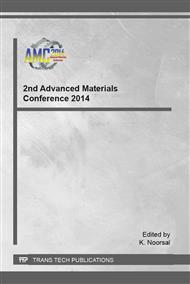[1]
C. Quinonez, W. Vallejo, G. Gordillo, Structural, optical and electrochemical properties of TiO2 thin films grown by APCVD method, Applied Surface Science. 256 (2010) 4065-4071.
DOI: 10.1016/j.apsusc.2010.02.020
Google Scholar
[2]
C.J.W. Ng, H. Gao, T.T.Y. Tan, Atomic layer deposition of TiO2 nanostructures for self-cleaning applications, Nanotechnology. 19 (2008) 445604.
DOI: 10.1088/0957-4484/19/44/445604
Google Scholar
[3]
M. Ritala, M. Leskela, Atomic layer epitaxy- a valuable tool for nanotechnology, Nanotechnology. 10 (1999) 19-24.
DOI: 10.1088/0957-4484/10/1/005
Google Scholar
[4]
H. Kim, H.B.R. Lee, W.J. Maeng, Applications of atomic layer deposition to nanofabrication and emerging nanodevices, Thin Solid Films. 517 (2009) 2563-2580.
DOI: 10.1016/j.tsf.2008.09.007
Google Scholar
[5]
D.M. King, Quantum confinement in amorphous TiO2 films studied via atomic layer deposition, Nanotechnology. 19 (2008) 445401.
DOI: 10.1088/0957-4484/19/44/445401
Google Scholar
[6]
C.X. Shan, X. Hou, and K.L. Choy, Corrosion resistance of TiO2 films grown on stainless steel by atomic layer deposition, Surface and Coatings Technology. 202 (2008) 2399-2402.
DOI: 10.1016/j.surfcoat.2007.08.066
Google Scholar
[7]
C.X. Shan, Improvement in corrosion resistance of CrN coated stainless steel by conformal TiO2 deposition, Surface and Coatings Technology. 202 (2008) 2147-2151.
DOI: 10.1016/j.surfcoat.2007.08.078
Google Scholar
[8]
M.W. Ribarsky, Handbooks of optical constants of solids, Academic Press, Altanta Gorgia, (1985).
Google Scholar
[9]
Z. Yanqing, Hydrothermal preparation and characterization of brookite-type TiO2 nanocrystallites, Journal of Materials Science Letters. 19 (2000) 1445-1448.
Google Scholar
[10]
A. Wisitsoraat, Gas-sensing characterization of TiO2-ZnO based thin film, 2006 IEEE Sensors. 1-3 (2006) 964-967.
DOI: 10.1109/icsens.2007.355784
Google Scholar
[11]
A. Fujishima, T.N. Rao, D.A. Tryk, Titanium dioxide photocatalysis, Journal of Photochemistry and Photobiology C: Photochemistry Reviews. 1 (2000) 1-21.
DOI: 10.1016/s1389-5567(00)00002-2
Google Scholar
[12]
A.P. Alekhin, Structural properties of the titanium dioxide thin films grown by atomic layer deposition at various numbers of reaction cycles, Applied Surface Science. 257 (2010) 186-191.
DOI: 10.1016/j.apsusc.2010.06.061
Google Scholar
[13]
J. Aarik, Titanium isopropoxide as a precursor for atomic layer deposition: characterization of titanium dioxide growth process, Applied Surface Science. 161(2000) 385-395.
DOI: 10.1016/s0169-4332(00)00274-9
Google Scholar
[14]
A. Rahtu, M. Ritala, Reaction mechanism studies on titanium isopropoxide-water atomic layer deposition process, Chemical Vapor Deposition. 8 (2002) 21-28.
DOI: 10.1002/1521-3862(20020116)8:1<21::aid-cvde21>3.0.co;2-0
Google Scholar
[15]
J. Aarik, Influence of structure development on atomic layer deposition of TiO2 thin films, Applied Surface Science. 181 (2001) 339-348.
DOI: 10.1016/s0169-4332(01)00430-5
Google Scholar
[16]
M. Ritala, M. Leskela, E. Rauhala, Atomic layer exitaxy growth of titanium dioxide thin films from titanium ethoxide, Chemistry of Materials. 6 (1994) 556-561.
DOI: 10.1021/cm00040a035
Google Scholar
[17]
C. Ohara, Synthesis and characterization of brookite/anatase complex thin film, Applied Surface Science. 254 (2008) 6619-6622.
DOI: 10.1016/j.apsusc.2008.04.030
Google Scholar
[18]
K. Porkodi, S.D. Arokiamary, Synthesis and spectroscopic characterization of nanostructured anatase titania: A photocatalyst, Materials Characterization. 58 (2007) 495-503.
DOI: 10.1016/j.matchar.2006.04.019
Google Scholar
[19]
C. Edusi, G. Sankar, I.P. Parkin, The effect of solvent on the phase of titanium dioxide deposited by aerosol-assisted CVD, Chemical Vapor Deposition. 18 (2012) 126-132.
DOI: 10.1002/cvde.201106961
Google Scholar
[20]
K. Kukli, Atomic layer deposition of titanium oxide from TiI4 and H2O2, Chemical Vapor Deposition. 6 (2000) 303-310.
DOI: 10.1002/1521-3862(200011)6:6<303::aid-cvde303>3.0.co;2-j
Google Scholar
[21]
A. Niilisk, Structural study of TiO2 thin films by micro-Raman spectroscopy, Central European Journal of Physics. 4 (2006) 105-116.
Google Scholar
[22]
W. F. Zhang, Raman scattering study on anatase TiO2 nanocrystals, Journal of Physics D: Applied Physics. 33 (2000) 912.
Google Scholar


